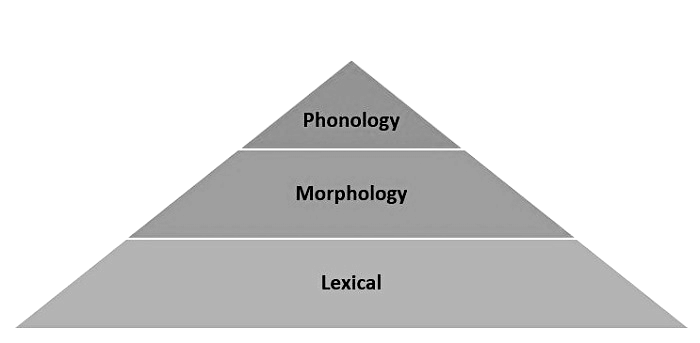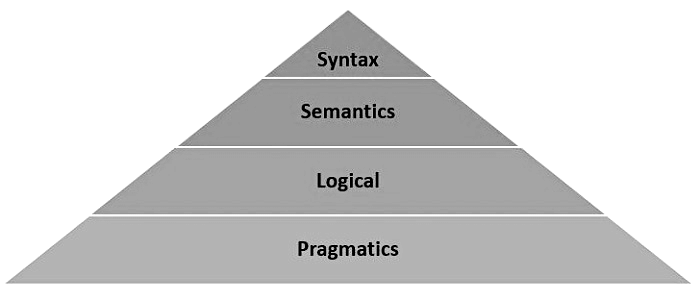Linguistic Hierarchy | Psychology for UPSC Optional (Notes) PDF Download
| Table of contents |

|
| Introduction |

|
| The Meaning of Linguistic Hierarchy |

|
| Levels of Linguistic Hierarchy |

|
| Conclusion |

|
Introduction
The essence of hierarchy lies in building fundamentals from one level to the next, forming a loose yet interconnected structure. Hierarchy is deeply ingrained in our world, although navigating it can be challenging. A pyramid often symbolizes hierarchy, with its height representing different levels and its breadth denoting the quality of each phase relative to the whole. The significance of hierarchy in fostering persistent progress across various fields of study cannot be overstated.
The Meaning of Linguistic Hierarchy
In the realm of language understanding, generation, and adoption theories, the assumption is that speakers comprehend and utilize hierarchical sentence construction. However, the sequential structure of language holds more foundational importance. Rather than engaging in hierarchical evaluation, words are typically merged into units with a vertical order within the human brain's cognitive system. The interpretation of a statement can vary depending on the reader's objectives, strategy, mental abilities, and circumstances.
Levels of Linguistic Hierarchy
Linguistic hierarchy encompasses several major levels, each playing a crucial role in the structure and meaning of language. Let's explore these levels in detail:
Phonology
Phonology involves the study of fundamental sounds, known as phonemes, which are distinct acoustic manifestations produced by speakers. For instance, the only phonological difference between the words "pat" and "bat" is the single consonant "t." These linguistic units are produced by carefully manipulating the lips and tongue. Phonemes form the foundational differentiating features of speech sounds. While certain sounds are unique to specific languages, others may be shared across different dialects. Stress and tone rules also contribute to phonetic distinctions.
Phonetics, on the other hand, focuses on the specific articulation and acoustic properties of sounds. English, for instance, has 95 consonant and 46 vowel notes, with approximately 40 unique sounds exclusive to the language.

Morphology
Morphology classifies the various sets of basic units, called morphemes, that convey meaning. A morpheme is the smallest meaningful unit of speech. Many words incorporate phonetic symbols as suffixes, such as adding "-ed" or "-ing" to verbs. Each word is constructed using one or more morphemes, and they naturally fit together to create meaning. Syntactic arrangement, known as word order, plays a vital role at this level. While most morphemes function as suffixes, some languages employ the technique of infixation, inserting words or phrases within others. This allows for significant shifts in grammatical and semantic functions.
Lexical
This level focuses on individual words as constituent elements that form a whole. Words can be used independently or combined into multi-morphemes, depending on the intended concept. Pronouncing a word repeatedly with an increasing volume can eventually lead to its recognition. The meanings and relationships between words can be interpreted in various ways. The significance of a word is encoded in its connections to other words. Constructing poetry or composing a song with specific constraints demonstrates the intricate organization of our mental lexicon.

Syntax
Syntax involves the utilization of our linguistic repertoire to express unique perspectives. For instance, a handbook on language may provide insights into morphology and phonology. The correct arrangement of terms in a specific sequence can convey a wealth of information. However, the communal usage of language is often limited by certain constraints. At the level of discourse, these limitations become mutually applicable, and multi-word sequences come into play. Syntax refers to the rules that govern the proper combination of morphemes to construct grammatically correct sentences. Each language has a specific set of rules governing sentence structure and word order. Understanding and adhering to these rules enables effective communication and facilitates the expression of complex thoughts.
Semantics
Semantics involves the association of meaningful goals with rational thought. It encompasses two primary categories: logical semantics and lexical semantics. Logical semantics is a means of articulating thoughts into words to convey meaning. Phrases can be expressed through conceptual meanings, such as fact-tentative semantics or paradigm-dependent semantics.
Pragmatics
Pragmatics focuses on the relationship between language and context. It explores how language is used to express oneself in social settings, ensuring that the intended message is effectively conveyed. Pragmatics involves understanding the nuances of language usage, such as tone, gesture, and cultural context, to achieve successful communication.
Conclusion
In conclusion, understanding linguistic hierarchy is essential for unraveling the intricate layers of language. From the fundamental phonological distinctions to the pragmatic considerations of context, each level plays a crucial role in shaping language comprehension, generation, and adoption. By following the guidelines and rules associated with each level, individuals can enhance their linguistic abilities and deliver impactful presentations or convey their thoughts effectively.
|
160 videos|215 docs
|















